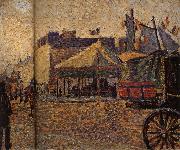Wholesale Oil Painting No Minimum |
|||||||||||
|
|
|||||||||||

|
|||||||||||
|
|
|
||||||||
Paul Signac1863-1935 French Paul Signac Galleries Paul Victor Jules Signac was born in Paris on November 11, 1863. He followed a course of training in architecture before deciding at the age of 18 to pursue a career as a painter. He sailed around the coasts of Europe, painting the landscapes he encountered. He also painted scenes of cities in France in his later years. In 1884 he met Claude Monet and Georges Seurat. He was struck by the systematic working methods of Seurat and by his theory of colours and became Seurat's faithful supporter. Under his influence he abandoned the short brushstrokes of impressionism to experiment with scientifically juxtaposed small dots of pure colour, intended to combine and blend not on the canvas but in the viewer's eye, the defining feature of pointillism. Many of Signac's paintings are of the French coast. He left the capital each summer, to stay in the south of France in the village of Collioure or at St. Tropez, where he bought a house and invited his friends. In March 1889, he visited Vincent van Gogh at Arles. The next year he made a short trip to Italy, seeing Genoa, Florence, and Naples. The Port of Saint-Tropez, oil on canvas, 1901Signac loved sailing and began to travel in 1892, sailing a small boat to almost all the ports of France, to Holland, and around the Mediterranean as far as Constantinople, basing his boat at St. Tropez, which he "discovered". From his various ports of call, Signac brought back vibrant, colourful watercolors, sketched rapidly from nature. From these sketches, he painted large studio canvases that are carefully worked out in small, mosaic-like squares of color, quite different from the tiny, variegated dots previously used by Seurat. Signac himself experimented with various media. As well as oil paintings and watercolours he made etchings, lithographs, and many pen-and-ink sketches composed of small, laborious dots. The neo-impressionists influenced the next generation: Signac inspired Henri Matisse and Andr?? Derain in particular, thus playing a decisive role in the evolution of Fauvism. As president of the Societe des Artistes Ind??pendants from 1908 until his death, Signac encouraged younger artists (he was the first to buy a painting by Matisse) by exhibiting the controversial works of the Fauves and the Cubists. |
||||||||
|
|
||||||||
Square
Square Painting ID:: 36908 |
mk115
1888
Oil on palette
27.5x35.6cm
mk115 1888 Oil on palette 27.5x35.6cm |
|||||||
|
|
||||||||
|
heinrich hansen Heinrich Hansen (13 October 1861 ?C 17 April 1940) was a German Lutheran theologian and the father of the Lutheran High Church movement in Germany. Hansen was born in Klockries near Lindholm (Nordfriesland) as a son of a teacher. In Kiel and Erlangen he studied theology, Hebrew, Syriac, Arabic and in particular the Old Testament under August Klostermann. He worked since 1887 as a pastor in Schleswig-Holstein: in Reinfeld, Lindholm, on the island Pellworm, in Kropp and in Olderup near Husum. Hansen wrote Latin hymns and worked on a Low German Bible translation and published a Low German hymnal. By the study of the old Lutheran theologians, particularly Martin Chemnitz, and the Roman Catholic theologian Johann Adam Möhler, he came to an Evangelical Catholic view about church. In the Reformation jubilee year of 1917??exactly 100 years after Claus Harms?? Hansen published 95 theses (Stimuli et Clavi) in Latin and German, as a sharp criticism against contemporary Protestantism. His theses influenced the foundation of "Hochkirchliche Vereinigung" in October 1918. Hansen is well-known as a co-founder and the first chairman of Hochkirchliche Vereinigung. He died in Breklum Square Date 1851 cyf |
||||||||
|
|
||||||||
|
Prev Next
|
||||||||
|
|
||||||||
|
Related Paintings to heinrich hansen :. |
||||||||
|
|
||||||||
|
CONTACT US |

